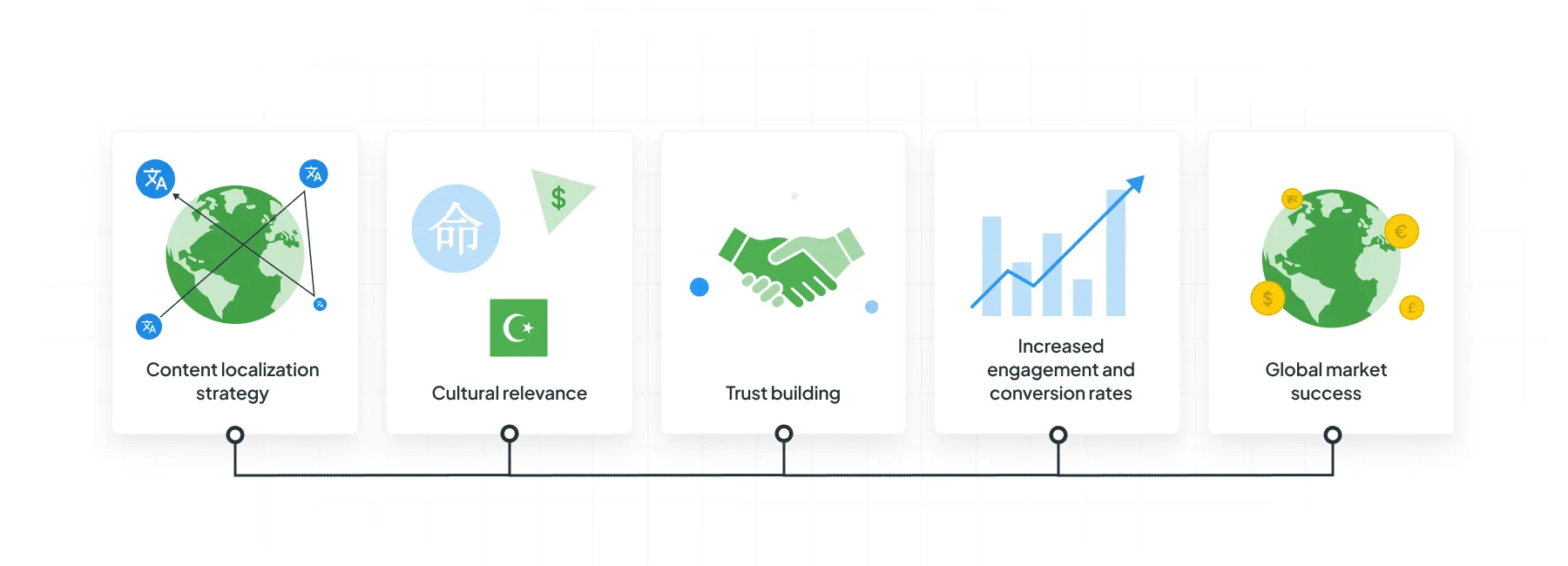Adapting and localizing your content is crucial for success. It helps businesses connect with global audiences that do not speak other languages. With global growth as your goal, сontent localization and a comprehensive TMS are a must. Without them, you won’t be able to expand your reach and impact worldwide.
This comprehensive guide covers:
- key definitions
- strategic translation workflows
- step-by-step implementation processes
- measurement techniques
- expert recommendations to help localize your content.
You’ll discover how localizing content:
- drives higher engagement and conversion rates
- builds trust with global audiences
- increases revenue in foreign markets.
Key Takeaways for Content Localization Success
Content localization is an important strategy for achieving global business success. Localized content delivers higher engagement rates than generic translations.
5 critical success factors:
- Comprehensive cultural adaptation goes beyond translation. It also includes style guides, technical, and visual elements.
- Localization is a systematic process. It relies on proper planning, native expertise, and quality assurance protocols.
- Strategic content prioritization. Focus resources and content localization efforts on high-impact materials that influence customer decisions.
- Data-based continuous measurement and optimization. Collect local market feedback and performance metrics.
- Long-term commitment. Dedication to understanding and serving local audiences’ authenticity
The evidence of localization’s importance is overwhelming. Businesses that invest in a comprehensive localization strategy achieve:
- Superior market penetration
- Customer engagement
- Revenue growth in international markets.
How to Start Creating Localized Content?
Start building your solid content localization strategy today to capture these competitive advantages. Begin your localization journey by:
- conducting thorough market research
- auditing existing content for localization potential
- partnering with experienced localization services providers
Remember that successful localization includes more than content translation. It requires ongoing investment in cultural understanding and local market relationships.
Content Localization and Its Importance for Global Growth
Content localization is the process of adapting content to fit the cultural, linguistic, and regional preferences of specific target markets. It is much more than translation. Localizing content also requires attention to:
- currency formats
- imagery and visual elements
- cultural references
- local context, specific to the global audiences
76% of consumers prefer to buy products with information in their native language. The data is according to CSA Research. This makes a solid localization strategy critical for global business success. By localizing your content, businesses can:
- reach global audiences
- support global growth
- ensure their messaging resonates across diverse markets
Investing in content localization leads to 1.5-2x higher conversion rates. This is the data compared to businesses using generic translated content. The evidence is clear: localization is essential for serious international market participation.
Understanding Content Localization: Key Concepts and Definitions
Let’s review some of the key definitions and concepts. This will help businesses better understand all aspects of the localization processes. It is also essential for connecting with global audiences on a deeper level.
Core Definitions
Localization (l10n) of content encompasses cultural and linguistic adaptation beyond translation. It also includes:
- currency symbols
- date formats, imagery
- color symbolism
- cultural references that resonate with local audiences.
Localization ensures your target audience experiences content as something created for them. This way, international audiences are more related to the product. Result: higher conversion rates in a specific market.

Other key terminology includes:
- Translation: Converting text from one language to another language
- Internationalization (i18n): Preparing source content for localization
- Transcreation: Creative translation focusing on emotional impact and cultural nuance
- Localization services: Professional providers offering comprehensive cultural adaptation
Concept Relationships
Content localization connects to:
The relationship flows as a system:
Content localization strategy → Cultural relevance → Trust building → Increased engagement and conversion rates → Global market success

Effective localization integrates with:
- translation management systems
- content strategy frameworks
- quality assurance protocols.
This connection ensures your localization efforts align with broader business objectives. At the same time, maintaining brand consistency across multiple markets is essential.
Adjusting KPIs
Here’s what’s important when measuring the success of your localization efforts. Core market key performance indicators (KPIs) may not be appropriate for new markets. Businesses should adjust metrics to fit the local audience. Rather than relying on standard conversion rates, focus on brand awareness and customer engagement.
Industry-Specific Localization Considerations
Many industries use their unique terminology. Additionally, they have established norms and regulations, and have user expectations. Precise attention to various aspects of localization is vital. It aids to ensure quality adaptation of the product or service. Let’s take a closer look at industry-specific considerations:
E-commerce:
- UI
- technical files and documents
- adapting time, date, and currency to local formats
- compliance with local buying habits.

Learn more about e-Commerce marketing localization from our dedicated blog post.
Finance:
- compliance with the local regulations
- usage of the industry jargon and terms
- secure user data storage.

Healthcare:
- attention to the medical terms
- compliance with the healthcare regulations of the foreign country
- local nuance consideration when talking to patients.
Cultural Localization Beyond Translation
A successful global content strategy requires more than accurate translation. True localization means adapting your content and experiences. These should fit the cultural context of each market. Such a process ensures that your brand feels natural and relevant to local audiences.

Understanding Cultural Nuances and Context
Every culture has unique communication styles, idioms, humor, and sensitivities. What sounds persuasive in one language may come across as rude or confusing in another. Effective localization requires an understanding of these nuances. Choosing the right tone, formality level, and storytelling techniques to build authentic connections.
Localize Visual Elements
Imagery, color, and design choices can mean different things worldwide. The color that symbolized joy in Western culture. Yet, in Asian countries, associations cannot be as joyful. To resonate with the locals, you must adjust imagery, graphs, and other visuals.
Localizing User Interface and User Journey
A good user experience depends on more than translated text. Date formats, currencies, address fields, and even navigation flows should reflect local norms. Tailoring the user interface (UI) and user journey helps remove friction. It makes your digital products feel intuitive in every market.
Addressing Local Market Preferences
Buying habits, preferred payment methods, and communication channels vary across regions. Consumers may prefer WhatsApp or WeChat over email. In others, credit cards are less common than digital wallets. Understanding and adapting to these preferences impacts conversion rates and customer satisfaction.
Creating Relevant Messaging
Cultural resonance is the ultimate goal of localization. Messaging should reflect local values, aspirations, and lifestyles. To match what matters most to local audiences, this may mean adjusting:
- slogans
- promotional campaigns
- product positioning
Locals perceive brands that succeed here not as outsiders, but as trusted partners.
Understanding Local Audiences
A successful localization strategy begins with a deep understanding of your local audiences. This means going beyond surface-level demographics. Uncover the unique preferences, behaviors, and cultural nuances that define each target market.

Start with Global Market Research
The process of localization should always start with thorough market research and analysis of:
- how your intended audience consumes content
- what resonates with the locals
- what local expectations shape their buying decisions
Work with Local Experts
To create content that connects, it’s essential to engage local experts. They can provide insights into cultural subtleties and help you avoid common pitfalls. Gather feedback from these local experts and leverage data analytics. It will allow you to refine your localization strategy. It helps ensure your messaging aligns with the values and interests of your audience.
Understand your Global Audiences
Businesses can boost their international engagement and conversion rates. How? By localizing your content to reflect the language, cultural background, and needs of each market.
A solid localization strategy requires a deep understanding as a foundation. Knowing your local audiences and using that knowledge throughout the localization process.
Step-by-Step Guide to Implementing Content Localization Process
You don’t know where to start – we’re here to help. We have prepared a step-by-step guide to help you get started with localization.

Step 1: Market Research and Content Localization Strategy Planning
Market Research
Conduct a comprehensive market analysis, including:
- language preferences
- cultural nuances
- competitor strategies
- regulatory requirements for your target regions.
This foundation prevents costly mistakes. It also ensures your localization strategy aligns with local market realities.
Market prioritization checklist:
- Revenue potential and market size analysis
- Cultural complexity assessment
- Competitive landscape evaluation
- Legal and regulatory requirements review
- Available localization resources assessment
Create a Customer Persona
Create detailed audience personas for each target market. Incorporate cultural insights, content consumption patterns, and preferred communication styles. Understanding your intended audience beyond demographics improves localization effectiveness.
- Outline Your Strategy and Goals
- Develop a comprehensive localization strategy document. It should contain clear objectives, timelines, success metrics, and budget allocations. This document guides decision-making throughout the localization and ensures stakeholder alignment.
Step 2: Content Audit and Localization Preparation
Prioritization
Perform a thorough content inventory, categorizing materials by priority, complexity, and localization requirements. Not all existing content requires equal localization investment. Focus resources on high-impact materials that influence customer decisions.
Content prioritization framework:
- Top priority: Product pages, landing pages, checkout processes
- Medium priority: Blog content, marketing collateral, social media posts
- Lower priority: Internal documentation, secondary support content
Style Guides and Guidelines
Create comprehensive style guides, glossaries, and brand guidelines for each target market. These resources ensure consistency across your localization team. Additionally, they maintain brand integrity while adapting to local contexts.
Step 3: Execute Localization and Quality Assurance
Work with Local Experts
Start localization by using native speakers with subject matter expertise and cultural knowledge. Professional localization services provide linguistic accuracy. At the same time, ensuring cultural appropriateness and local market relevance.
Quality Assurance
Establish multi-stage quality assurance protocols:
- Linguistic review: Grammar, syntax, and terminology accuracy
- Cultural validation: Appropriateness and local context verification
- Technical testing: UI functionality and visual elements
- Market feedback integration: Local expert and customer input incorporation
Track Progress
Deploy localized content through appropriate channels with proper tracking and monitoring systems. Use KPI specific to each local market to measure success and identify optimization opportunities.
Collect Customer Feedback
Create feedback loops with local market teams and customers for continuous improvement. Regular feedback collection enables iterative refinement of your localization efforts.
Best Practices for Effective Content Localization
To achieve long-term global success, businesses must treat localization as an ongoing strategy. Not a one-time project. We have compiled a list of best practices. These will help your business resonate with the locals.
Building a Successful Localization Team
A dedicated team is the foundation of effective localization. This includes:
- project managers
- translators
- editors
- cultural consultants
They must work together to align content with local expectations. Having a clear workflow and defined roles ensures consistency and quality at scale.
Working with Native Speakers and Local Experts
Native speakers bring cultural insight that goes far beyond word-for-word translation. Collaborating with local experts is essential. It ensures your messaging reflects the tone, idioms, and cultural norms of the market. Such attention makes your content authentic and relatable.
Maintaining Brand Consistency Across Languages
While adapting content for local markets, it’s essential to preserve your brand’s voice, values, and identity. Style guides, glossaries, and translation memory tools help maintain consistency. This promotes unified brand association across all markets, regardless of language.
Optimizing Translation Workflow Efficiency
Efficiency is key when localizing large volumes of content. Leveraging technology optimizes the process, reduces errors, and shortens time-to-market. Main technology includes:
- translation management systems (TMS),
- AI-powered localization tools,
- centralized content platforms
Continuous Improvement and Feedback Integration
Localization is a continuous process. It is never a completed process. Several processes allow you to refine your strategy over time:
- gathering user feedback
- monitoring performance metric
- staying updated on cultural shifts
Regular audits and updates ensure that your localized content remains relevant.
Content Localization Software: Tools and Technology
Leveraging content localization software is essential. It enables the management of localization complexities. Especially when dealing with many language versions and large-scale localization efforts. A robust translation management system (TMS) allows you to:
- manage workflows
- automates repetitive tasks
- facilitates collaboration among localization teams
Such a platform ensures that your content strategy remains efficient and scalable.
Localize Your Content with Crowdin
The right localization software is a must. With it, businesses can maintain consistency and accuracy across all multilingual content. This reduces the risk of errors and saves valuable time. Several tools help optimize the translation workflow, including:
- translation memory
- machine translation platforms
- integrated project management systems
This, in turn, makes it easier to update and manage content for different markets.

Translation Memory
Translation memory keeps track of all translations with localization software terms. Crowdin will showcase suggestions for previous translations. It is better to additionally re-check them, but your team will still save lots of time and money.
Machine Translation Process
Another helpful tool from Crowdin is machine translation. It will help localize your content. You can translate a vital piece of information, even without a translator.
Alignment with Goals
Incorporating content localization software, such as Crowdin, into your global marketing strategies:
- improves quality and speed
- supports better alignment with your business objectives.
By investing in the Crowdin localization software, you can:
- enhance your localization efforts
- deliver a great user experience across all language versions
- achieve greater impact in international markets.
Overcoming Cultural Barriers in Localization
Navigating cultural barriers is one of the most challenging aspects of localization strategy. You must focus on creating content that resonates with your target audience. It’s crucial to understand and respect:
- cultural nuances
- traditions
- values
These are the factors that shape their perceptions and behaviors. A good localization strategy involves more than translating words. It requires cultural sensitivity and a commitment to authenticity.
Avoid Common Mistakes
Working with local experts and conducting thorough market research are key steps. It helps with:
- identifying potential cultural pitfalls
- ensuring your content is both relevant and respectful.
Cultural sensitivity training for your localization team is also important. It can enhance your ability to create content that avoids misinterpretation or offense.
Consider Cultural Nuances
It’s important not to compromise quality by:
- relying on automated translation tools alone
- overlooking the importance of cultural adaptation
By prioritizing cultural nuances and engaging with local audiences, businesses can:
- build trust
- credibility
- lasting relationships
Managing Costs in Localization
Managing costs is a vital component of any localization. Striking the right balance between quality and budget requires a strategic approach. It will help leverage technology and expertise without sacrificing quality or cultural relevance.
- Choose the Right Tools. A good localization strategy incorporates cost-effective solutions. These allow to manage the localization process and reduce expenses, and include
- translation memory tools
- machine translation platforms
- project management systems
- Understand your Global Audiences. Localize your content by collaborating with experienced localization teams. Additionally, conduct comprehensive market research. These processes ensure accuracy, engagement, and tailoring of the content to target audiences.
- Track Performance. Use data analytics to track performance and make informed decisions. It helps maximize ROI. It also ensures the focus of the localization efforts on high-impact areas.
By managing costs and maintaining a commitment to quality and culture, businesses can:
- create localized content that drives engagement
- boosts conversion rates,
- support sustainable growth worldwide.
All these without compromising on the standards that matter most.
Common Content Localization Mistakes to Avoid
Mistake 1. Treating localization as simple translation without considering cultural context and local preferences. This approach often results in technically correct but culturally inappropriate content. Such content fails to engage local audiences.
Mistake 2. Equal content localization instead of prioritizing high-impact materials based on:
- customer journey analysis
- business objectives
Resource allocation should focus on content that influences conversion decisions.
Mistake 3. Neglecting technical aspects. These include UI adaptation, date formats, currency symbols, and right-to-left language support. These technical elements have a high impact on user experience quality.
Real-Life Content Localization Success Story
Case Study. How Polhus used Crowdin’s AI and DatoCMS integration for website localization.
Starting Situation. Polhus updated their website design which mostly consisted of sweedinsh-native content. To ensure they can reach international users and maintain high quality across markets, they had to localize their website. For this specific project, the company mainly focuses on localizing the website text.
Implementation Steps:
- Glossary translation. The initial step before working on the website content was to translate all terms within the glossary. This allows for keeping translation consistency throughout all texts.
- Localization workflow set up. This process included several vital steps that ensured quality translation of the text.
- Integration with DatoCMS. By integrating Polhus’ content management system through the Crowdin app, the company could synchronize all website content for translation.
- AI Translations. Crowdin’s AI pre-translation feature, with the use of the OpenAI (ChatGPT 4) model, delivered the translations, 75% of which did not require any adjustments from the professionals.
- Human Review. The team of experts rewrote the AI-generated translations, only 25 of which needed improvement.
Results achieved:
- 75% of AI-generated content was publish-ready
- ensured glossary consistency across all translated text
- $80,000 was saved on contact localization
- posting-ready content within days
This success demonstrates how a comprehensive localization strategy extends beyond translation. It encompasses consistency, technical integration, and customer experience optimization.
Future Trends in Localization
The future lies in technology. With its rapid development, the center of localization will be around automation tools. Such tools will ease the process of translation and content adaptation.
Here’s the list of the most vital localization trends:
- AI development. AI has integrated every part of our lives, including localization. It will be further used to:
- automate translation workflows,
- keep track of the progress and performance metrics
- help create more efficient content.
- Real-time translation. New technologies will allow for instant translation of any content. No matter how big or complex it is. This will shorten the time spent on localization of content. Which, in turn, will allow to enter the global markets quicker.
- Personalization. Creating personalized content is already the main selling point for every industry. The focus will contribute to creating culture-sensitive products and services. There will be more and more attention to the local nuances and relevance.
Final Thoughts
Content localization is no longer optional for businesses aiming to grow. It is a strategic necessity. By going beyond translation and adapting content to local cultures, businesses can:
- create stronger connections
- improve customer experiences
- drive global success.
Next Steps for Implementing Localization Strategy
Begin by auditing your existing content and identifying priority markets:
- Build a dedicated localization team or partner with local experts
- Establish style guides to maintain brand consistency.
- Invest in translation management tools to optimize your workflows
- Set up systems for regular feedback and updates.
The Competitive Advantage of Localized Content
Companies that invest in localization gain a distinct competitive advantage. They’re seen not as outsiders. But as brands that understand and respect their customers’ culture. This leads to:
- higher engagement
- stronger brand loyalty
- greater global market share
FAQ
What’s the difference between translation and localization?
Translation converts text between different languages. While localization is about cultural content adaptation for specific markets, including:
- imagery
- colors
- currency formats
- cultural references
- local context
How much does content localization cost?
Professional localization services range from $0.10-$0.30 per word for translation. Be mindful of extra fees for cultural adaptation, technical implementation, and quality assurance. Total project costs depend on content volume and complexity.
Which content to localize first?
Focus on high-conversion content. It includes product pages, landing pages, checkout processes, and customer support materials. These impact buying decisions and user experience quality the most.
How do you measure localization success?
Track local market KPI, including:
- engagement rates
- conversion rates
- customer satisfaction scores
- time on page
- revenue per visitor
- market penetration
Should I localize visual elements?
Yes, localizing visual elements in target regions is essential. Including imagery, colors, symbols, and design layouts improves cultural relevance and user engagement.
Yuliia Makarenko
Yuliia Makarenko is a marketing specialist with over a decade of experience, and she’s all about creating content that readers will love. She’s a pro at using her skills in SEO, research, and data analysis to write useful content. When she’s not diving into content creation, you can find her reading a good thriller, practicing some yoga, or simply enjoying playtime with her little one.
